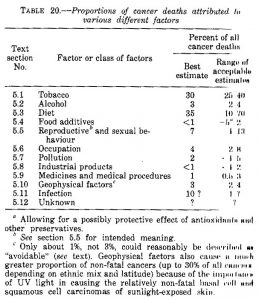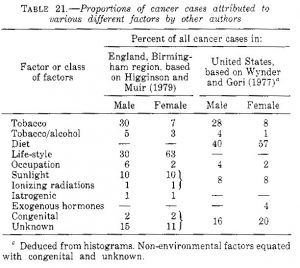
(Photo from http://rs91.pbsrc.com/albums/k305/isisazna/numerology1.jpg?w=280&h=210&fit=crop)
From Wikipedia: “In epidemiology, a risk factor is a variable associated with an increased risk of disease or infection.”
Generally, it is a disease or infection which results in death. Lung cancer for example. The determination of a risk factor is done by comparing two otherwise identical population samples, where one is exposed to the ‘risk factor’ and the other is not.
Suppose that we have one sample exposed to a risk factor (we’ll call it F1). And that 200 deaths occur in that sample compared to 100 deaths in the non-exposed sample. Assuming both samples are the same size then that represents a relative risk (RR) of 2 (twice as many deaths).
Correlation does not imply causation but if we accept that the relationship is causal then the extra 100 deaths can be attributed to risk factor F1. 50% of the deaths in the exposed sample.
Such attribution sounds eminently reasonable and that is generally how epidemiologists and the media report them.
Next, suppose that our valiant epidemiologists conduct a similar trial but on another risk fact (we’ll call that F2) and find the same RR. So, in this new study, 50% of deaths are attributed to F2.
So, consider what happens in a population that is exposed to both F1 and F2. Taking the above figures at face value, we can attribute 50% of deaths to F1 and 50% to F2. So we’ve accounted for 100% of deaths.
With 3 risk factors we’ll end up accounting for 150% of all deaths. And the more risk factors that you add in, the crazier it gets.
The number of possible risk factors is to all intents and purposes infinite, some identified, some not. Epidemiologists have already identified over 100 for lung cancer and over 500 for heart disease.
There is a formula for ‘attributable risk’ that tries to avoid these pitfalls. However, this makes several assumptions. Notably that ALL risk factors and the interactions between them have been identified – this is of course impossible.
The eminent psychologist Hans Eysenk described this as ‘Alice in Wonderland Arithmetic’ on pages 8 and 9 of his book).
This was also brought up with an additional twist in the McTear vs ITL court case:
[5.147] …” There is a tendency to think that the sum of the fractions of disease attributable to each of the causes of disease should be 100%. For example, in their widely cited work, The Causes of Cancer, Doll and Peto (1981: Table 20) created a table giving their estimates of the fraction of all cancers caused by various agents; the total for the fractions was nearly 100%. Although they acknowledged that any case could be caused by more than one agent (which would mean that the attributable fractions would not sum to 100%), they referred to this situation as a ‘difficulty’ and an ‘anomaly’. It is, however, neither a difficulty nor an anomaly, but simply a consequence of allowing for the fact that no event has a single agent as the cause. The fraction of disease that can be attributed to each of the causes of disease in all the causal mechanisms has no upper limit: For cancer or any disease, the upper limit for the total of the fraction of disease attributable to all the component causes of all the causal mechanisms that produce it is not 100% but infinity. Only the fraction of disease attributable to a single component cause cannot exceed 100%.”
Here is table 20 from ‘The Causes of Cancer’ by Doll and Peto (1981) – Oxford Medical Publications. Reproduced here for public interest and fair comment.

They also included a further figure (table 21) showing published figures by other researchers:

Notice how in each case the figures total to 100%. Also, how ‘infection’ is either very low or non-existent in these tables.
This is where the oft quoted 50-70% of cancers are caused by lifestyle and are preventable comes from. CRUK still peddle this.
The fact that the main cause of cervical cancer and (probably) a high proportion of head and neck cancers are now known to be caused by the ‘human papillomavirus (HPV)’, seems to have passed them by.
